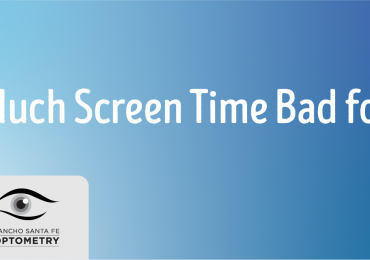When shopping for clothes and accessories it’s a given that everyone has a unique size and shape. If you’re picking out pants, for example, and you try on 3 pairs all in the same size, some will fit you like a glove, and some, not at all. The same thing applies when picking out glasses. Frames have measurements just like anything else (most common number to know is the “A” measurement which is the lens width in millimeters). A size 52mm in a round frame might fit and look great, whereas a 52 eye size in a square frame might not look good at all. Which is where we come in! We are here to help you find the frames that not only look great, but fit great too. These four things are important to keep in mind when you’re ready to look for a new frame and are the four things that the experienced opticians at Rancho Santa Fe Optometry use as preliminary considerations when helping patients with selections.
#1: SIZE
As we mentioned above, all frames have measurements. The basic measurements to know are lens size (which is the width of one lens from edge to edge in millimeters), bridge size (which is the part that goes over your nose – hence the name – measured from the inner corner of one lense to the other) and the length of the temples which connect the front of the frame on either side and rest behind your ears. Generally speaking, your eyes should be positioned in the center of the lens, the bridge shouldn’t have a gap OR be too wide so that the frame sits low, and the temples (although they can be adjusted) shouldn’t be too long or too short.
One other consideration that can affect fit is the type of material of the frame. The two categories are metals or plastics. Metal frames will have nose pads which have an added point of adjustment. For those that have a flatter bridge, nose pads will be helpful in positioning the frame so that it doesn’t rest on your cheeks.
#2: LIFESTYLE
What you do on the daily is a big part of how your glasses can support you to give you the best vision. For example, single vision (meaning the lenses only correct vision for one distance) lenses will only help you see either distance or near so if you’re working at a desk all day or outside all day, one lens type would be more beneficial than the other. If you’re someone who needs correct at all distances, a multifocal or progressive lens would be the best option. Because these lenses have distance blended all the way to near in the same lens, you want to make sure there is enough room for eyes to use each part of the lens. Therefore when you’re choosing a frame, it’s best to consider first how you will use them.
#3: STYLE
There are glasses for all types. To find the best one for you, considering your personal style first, will help narrow down what you’re looking for. Do you want a big, bold, colorful frame? Do you want something that has no frame around the lens that blends in and doesn’t cover up your facial features? Do you want multiple pairs to switch between styles? Do you want prescription sunglasses so that you can feel protected from the sun and have clear vision? Knowing where you fall in the realm of style will help our opticians guide to a frame that suits your the best.
#4: COLOR
Lastly, each person has different color palettes in their features and these three tips should help you in determining what yours are:
- Skin: Skin tone is the prime element in determining coloring. All complexions fall into one of two color bases — blue (cool) or yellow (warm). A cool complexion has blue or pink undertones, and a warm complexion has a “peaches and cream” or yellow cast. Olive skin is considered cool because it is a mixture of blue and yellow. In the United States, cool, blue-based complexions are more common than the yellow-based warm complexions. About 60 percent of the population are “cools.”
- Eyes: Eye colors usually are a secondary element in determining coloring because of the many variations of eye color. For example, blue eyes can range from a cool almost-violet to a pale blue-gray, which is warm. Brown eyes can vary from a light cider shade (warm) through a medium-brown to a cool almost-black.
- Hair: Hair colors also are considered warm or cool. Strawberry blond, platinum, blue-black, white, auburn, salt-and-pepper and ash brown are cool. Warm hair colors include golden blond, brownish black, brown-gold, “carrot” and “dirty” gray.
We love what we do and we would love to help you pick out your next pair of glasses. You don’t need an appointment to pick out glasses, just remember to bring a copy of your most recently glasses prescription. If you don’t have one use our appointment scheduler to pick a date and time to see Dr. Weiss.
If you enjoyed this blog, you might also enjoy reading 10 Great Reasons to Buy Your Eyewear from Rancho Santa Fe Optometry
At Rancho Santa Fe Optometry we offer comprehensive eye examinations for all ages. With a focus on children’s vision and vision therapy, our doctors test for visual acuity, visual efficiency skills and visual information processing starting in early infancy. The practice also provides diagnosis, treatment and management of diseases that affect the human eye and visual system, including dry eye syndrome, diabetic retinopathy, cataracts, macular degeneration and keratoconus.


